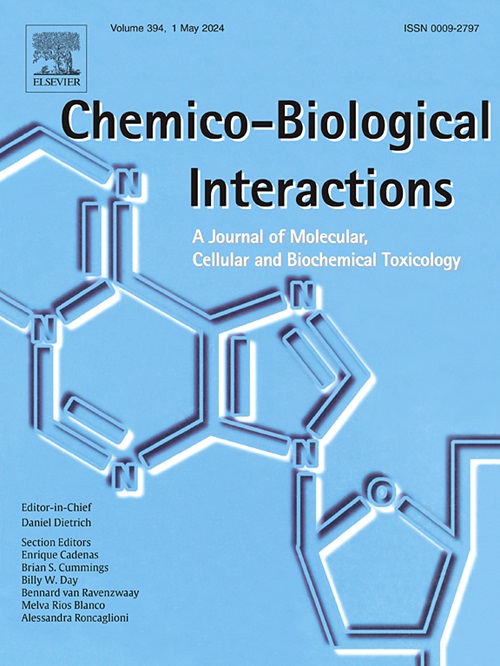Endoplasmic reticulum stress inhibition preserves mitochondrial function and cell survival during the early onset of isoniazid-induced oxidative stress
IF 4.7
2区 医学
Q1 BIOCHEMISTRY & MOLECULAR BIOLOGY
引用次数: 0
Abstract
A comprehensive understanding of isoniazid (INH)-mediated hepatotoxic effects is essential for developing strategies to predict and prevent severe liver toxicity in tuberculosis treatment. In this study, we used multi-omics profiling in vitro to investigate the toxic effects of INH, revealing significant involvement of endoplasmic reticulum (ER) stress, mitochondrial impairment, redox imbalance, and altered metabolism. Additional analysis using transcriptomics data from repeated time-course INH treatments on human hepatic microtissues revealed that cellular responses to ER stress and oxidative stress happened prior to disturbances in mitochondrial complexes. Mechanistic validation studies using time-lapse measurements of cytosolic and mitochondrial reactive oxygen species (ROS) revealed that INH initially triggered cytosolic ROS increasement and Nrf2 signaling pathway activation before mitochondrial ROS accumulation. Molecular imaging showed that INH subsequently disrupted mitochondrial function by impairing respiratory complexes I–IV and caused mitochondrial membrane proton leakage without affecting mitochondrial complex V, leading to mitochondrial depolarization and reduced ATP production. These disturbances enhanced mitochondrial fission and mitophagy. Our findings highlight the potential of inhibiting ER stress during early INH exposure to mitigate cytosolic and mitochondrial oxidative stress. We also revealed the critical role of Nrf2 signaling in protecting hepatocytes under INH-induced oxidative stress by maintaining redox homeostasis and enabling metabolic reprogramming through regulating antioxidant gene expression and cellular lipid abundance. Alternative antioxidant pathways, including selenocompound metabolism, HIF-1 signaling, and the pentose phosphate pathway, also responded to INH-induced oxidative stress. Collectively, our study emphasizes the importance of ER stress, redox imbalance, metabolic changes, and mitochondrial dysfunction that underlie INH-induced hepatotoxicity.
内质网应激抑制保留线粒体功能和细胞存活在异烟肼诱导的氧化应激的早期发作。
全面了解异烟肼(INH)介导的肝毒性作用对于制定预测和预防结核病治疗中严重肝毒性的策略至关重要。在这项研究中,我们使用体外多组学分析来研究INH的毒性作用,揭示了内质网(ER)应激、线粒体损伤、氧化还原失衡和代谢改变的显著参与。通过对人类特异性肝脏微组织进行重复时间过程INH治疗的转录组学数据的进一步分析显示,细胞对内质网应激和氧化应激的反应发生在线粒体复合物紊乱之前。利用时间推移测量细胞质和线粒体活性氧(ROS)的机制验证研究表明,INH在线粒体ROS积累之前首先触发细胞质ROS增加和Nrf2信号通路激活。分子成像显示,INH随后通过损害呼吸复合体I-IV来破坏线粒体功能,并在不影响线粒体复合体V的情况下引起线粒体膜质子泄漏,导致线粒体去极化和ATP产生减少。这些干扰增强了线粒体的分裂和自噬。我们的研究结果强调了在早期INH暴露期间抑制内质网应激以减轻细胞质和线粒体氧化应激的潜力。我们还揭示了Nrf2信号在inh诱导的氧化应激下通过维持氧化还原稳态和通过调节抗氧化基因表达和细胞脂质丰度实现代谢重编程来保护肝细胞的关键作用。其他抗氧化途径,包括硒化合物代谢、HIF-1信号传导和戊糖磷酸途径,也对inh诱导的氧化应激有反应。总的来说,我们的研究强调了内质网应激、氧化还原失衡、代谢变化和线粒体功能障碍的重要性,这些都是inh诱导的肝毒性的基础。
本文章由计算机程序翻译,如有差异,请以英文原文为准。
求助全文
约1分钟内获得全文
求助全文
来源期刊
CiteScore
7.70
自引率
3.90%
发文量
410
审稿时长
36 days
期刊介绍:
Chemico-Biological Interactions publishes research reports and review articles that examine the molecular, cellular, and/or biochemical basis of toxicologically relevant outcomes. Special emphasis is placed on toxicological mechanisms associated with interactions between chemicals and biological systems. Outcomes may include all traditional endpoints caused by synthetic or naturally occurring chemicals, both in vivo and in vitro. Endpoints of interest include, but are not limited to carcinogenesis, mutagenesis, respiratory toxicology, neurotoxicology, reproductive and developmental toxicology, and immunotoxicology.

 求助内容:
求助内容: 应助结果提醒方式:
应助结果提醒方式:


